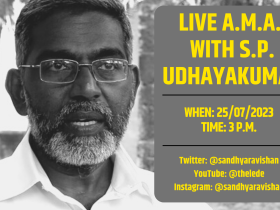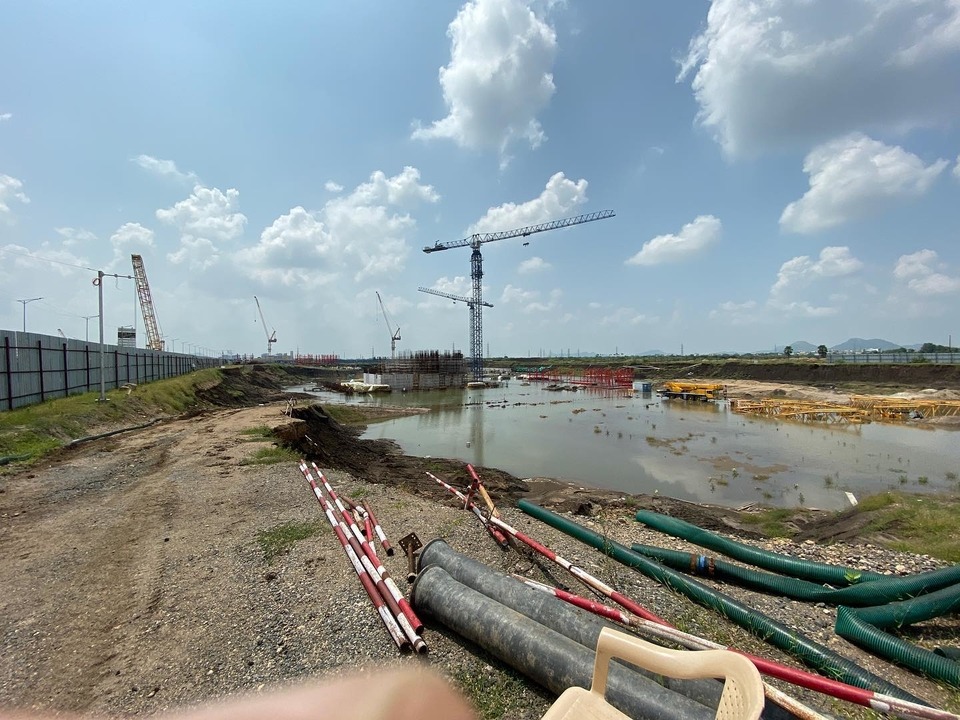It is an eerie drive along what was planned to be Amaravati, the much touted ‘People’s Capital’, hailed as India’s first international standard, planned, smart capital city.
Monolithic, still cranes atop half constructed apartment blocks and cement mixers without the grating churning sounds provide an ambience of uneasy peace.
Work has been abandoned everywhere – an Indian version of Apocalypse Now – no worker in sight, no yellow hard hats, no vehicles, no movement except for the odd bird that squawks overhead.
The breeze blows heavily. What were once multi crop fertile farmlands – jareebu or lands of gold – now hold concrete in them.
Partly constructed buildings look up at the sky with rusted rods and tonnes of sand and cement dumped by the roadside are covered in shrubs, damp from the rains of the previous day.
Stragglers near the temporary Andhra Pradesh High Court building situated within the capital city sigh perplexed.
“It is all going to waste,” they say. “What will happen to our capital?”
Anxious Farmers
In the village of Thulluru, a stone’s throw from the deserted capital city, Poovada Surendra is a nervous man. His extended family has given 20 acres of land for pooling, believing in the dream of a capital city sold by the previous chief minister Chandrababu Naidu.
Surendra has got plots allotted to him by the state government. But Assembly elections arrived in May 2019. And with that, a landslide victory for Jaganmohan Reddy’s YSR Congress. Work on Amaravati abruptly stopped as did most of Naidu’s pet projects.
“We believed that work would continue but everything has stopped,” he says, anxiety writ large on his face. “We are trying to ask the government when the work will begin again. All of us are afraid about what will happen now. We have all willingly given our lands because we wanted a capital city here. But now we don’t know the status,” he says.
Surendra is only one of thousands of farmers who gave their land for pooling, in a first of its kind exercise in 2014-15. Farmers who pooled their land were promised an annuity from the government in lieu of the crop income they would otherwise have had. Apart from this, the state promised them developed plots of land, depending on the classification and area that each farmer had pooled.
Farmers with jareebu lands (loosely translated to wet lands) would get annuity of Rs 50,000 along with a developed residential plot of 1000 square yards and a commercial plot of 450 square yards.
Farmers with metta lands (loosely translated to dry lands) or uplands would get annuity of Rs 30,000 along with a developed residential plot of 1000 square yards and a commercial plot of 250 square yards.
This is for each acre pooled by the farmers.
Factored in is a cost escalation component to the annuity – since June this year, jareebu farmers have got Rs 75,000 per acre and upland farmers have got Rs 45,000 per acre. In the tenth year of construction of the capital city, jareebu farmers would get annuity of Rs one lakh while upland farmers would get Rs 75,000.
While all of this is taking place, the fate of Amaravati hangs in the balance, with new chief minister Jaganmohan Reddy choosing to remain tightlipped about his next move and disallowing work to go on.
His second in command, Municipal Administration and Urban Development minister Botsa Satyanarayana made a throwaway comment about “discussions” being “on” and referring to the Sivaramakrishnan Commission of 2014 that went into the issue of a new capital city for divided Andhra Pradesh, which further sent rumour mills into a tizzy.
“Plot allocation has taken place in the core area,” continues Surendra. “But speculation is going on and government has not said anything concrete so far,” he says.
Surendra’s worries are echoed even by farmers who have pledged their allegiance to the ruling YSR Congress. Thulluru mandal president of the party Bathula Kishore told The Lede that everyone pooled their land notwithstanding their political affiliations.
“We all wanted the capital here. I did not give my land because Chandrababu Naidu was the CM or Jagan was the CM. I gave it for the capital,” he says.
Kishore says that he has conveyed to his seniors in the party that there is a mood of nervousness amongst farmers in the capital area about what will happen next.
“Of course everyone is afraid,” he says. “A lot of rumours are doing the rounds and I tell everyone who asks me not to worry and that everything will be okay, but still they worry. They are afraid about what will happen if the capital is shifted from here. What will happen to their lands? It is a legitimate concern,” he says.
“It has only been four months of the new government,” continues Kishore. “The farmers want to meet the CM and request him to start work on the capital again. I have asked them to wait for a few more months,” he says.
One of Jaganmohan Reddy’s key promises to the electorate in the run-up to the polls was to ensure that Chandrababu Naidu’s alleged corrupt activities vis a vis Amaravati and other projects like Polavaram would be enquired into and the guilty punished.
The other promise was to return the lands of farmers who had pooled it in unwillingly or which had been acquired for the capital city.
In late June too, Jagan reiterated that farmers who wanted their lands back and the “excess land” from Amaravati would be returned.
But this, says Poovada Surendra, is an improbable proposition. For starters, he does not want his agricultural land back, because he pooled it voluntarily for specific reasons.
“I am getting old and my children will not do agriculture,” says Surendra. “They will get into IT or some other job. They may not even live here. What will I do with agricultural land?
Another problem is that our land is unrecognisable now. They have laid roads, some amount of construction has been done. Some of our land has been re-registered to others as developed plots. My land now has been registered with other owners. Many of these developed plots have already been sold also.
How can the land be returned now?” he asks.
Bathula Kishore agrees. “Only some land can be returned,” he says. “The land that has not yet been touched. But in most places they have already built roads. Those who have got the developed plots are selling it to outsiders already. People from outside are coming, looking at the map of the plots and just buying, based on the map,” he says.
A bureaucrat who did not wish to be named told The Lede that the premise of Jagan’s promise itself was erroneous. “Jagan has been saying that people close to Naidu have been buying up lands ahead of the announcement of the capital city and that the whole thing was “fixed” to favour his cronies. Assuming that is true, who is he going to return the lands to? It is a godawful mess, the whole thing,” he said.
A clutch of farmers jointly owning 3600 acres though are certainly happy and relieved in the villages that fall under the capital city. These men from Rayapudi village dragged the state to Supreme Court and obtained a stay on acquisition of their lands by the government for the capital city.
“We have been fighting against this capital and this land pooling from the beginning just for this reason,” says Mallela Seshagiri, a firebrand farmer and human rights activist who hails from Rayapudi village. “Our question was – if this government falls, where do we go? Our words were prophetic it seems,” he smiles.
Of the 172 cases filed by farmers in various courts since 2014, 42 cases are now pending. “Taking over multi crop irrigated land is not allowed by the law but the Chandrababu government flouted every rule to build the capital,” says Seshagiri. “And he showed the farmers dreams in 3D. Unfortunately, everyone was mesmerised by it.”
Around 97% of farmers had voluntarily pooled their land and after setting deadlines for pooling, the Naidu administration went in for land acquisition for the remaining 3%.
These farmers, hailing from Rayapudi and Undavalli resisted and moved courts. Pathan Bikhari Khan, 45, owner of three acres in Rayapudi says power lines were cut for all farmers who refused to give up their land. “We irrigate our crops using the borewell so we could not run our pumps. They brought machines for road laying and ran it over our crops. The police would harass us by following us around everywhere without leaving us in peace,” he recalls.
Kothapalli Koteswara Rao, 60, got a rude shock when a road contractor dumped a mound of sand on his land.
“The contractor refused to remove it so I approached the sub-Collector. She said she would look into it but nothing happened. It is still there,” he rues.
“All of us are happy that the capital is here,” says Rao. “But Chandrababu gaaru (respectful term for male in Telugu) did not live up to any of his promises. He said he would give one government job per family, he would give developed plots within three years with electricity and power and roads. He has not done anything he promised,” he says.
“This is our village but outsiders came and bought up our lands. Is it fair?” he asks.
The irony of the situation is not lost on Thulluru farmer Poovada Surendra who admits that many farmers sold a portion of their land to realtors when their land prices skyrocketed from Rs 30 lakh an acre to close to Rs 3 to 5 crore an acre immediately after the announcement of the location of the capital city.
“Every farmer you meet here will admit that he has benefited from Chandrababu gaaru’s policies,” he says. “Many have become crorepatis overnight. Many have even left this place for good after selling their lands for huge sums,” he says.
How Amaravati Came To Life
‘The People’s Capital’ was designed and re-designed painstakingly by a variety of teams of international experts from Singapore and London to make it a Greenfield Capital.
Planned over 32,000 acres of the fertile lands of the Krishna basin, the capital city comprising the Secretariat, the AP High Court, the Assembly and government housing was to come up over an area of 217 square kilometres. The entire extended capital region was planned over 8603 square kilometres.
28,181 land owners consented to pool their land for the capital in exchange for smaller developed plots of commercial and residential lands.
A total of Rs 51,000 crore is the financial outlay for Amaravati capital city for the first three years. This amount includes Rs 188 crore towards annuity payments for land owners who have pooled land as well as Rs 60 crore towards pensions for the landless poor.
Amaravati is financed with Rs 1500 crore from the Centre, Rs 1250 crore from HUDCO (Housing and Urban Development Corporation), Rs 2060 crore from commercial banks and Rs 2000 crore from Amaravati bonds floated for the purpose. The state government of Andhra Pradesh pays the annuity and the pensions from its own account.
Amaravati’s Fate
Barely 15 kilometres from the hustle and bustle of Vijayawada, the not-yet-capital city of Amaravati looms in silence, awaiting its fate.
Six to eight multi-storeyed apartment complexes meant for government officials yawn over the otherwise flat skyline.
So what is likely to be the fate of Amaravati, named for the celestial abode of Indra, king of the mythical Hindu devas?
A senior official from the APCRDA (Andhra Pradesh Capital Region Development Authority), set up to build Amaravati, told The Lede, on condition of anonymity, that he expected work to begin shortly on the capital.
“Towers 1 to 5 are for the HoD buildings and these cover 72.5 lakh square feet,” he says. “The High Court is of 20 lakh square feet, the Assembly is planned for 17 lakh square feet. We have already completed part of the road works and reservoir works at Nelapadu. Canal works are in progress to prevent flooding in Amaravati from the Kondaveetivagu and Palavagu (streams from the Krishna river that annually flood the region).
34 trunk roads of 1 km X 1 km grids have been proposed of which 10 are main roads. All of these are in varying degrees of progress from 5% to 70% completion.
We have built the diagrid for up to two floors for the Secretariat building. Work on the Assembly is yet to begin.
The structures of 4024 residential units are ready, only the finishing needs to be done. Only 40% of the work is left and it can be completed in 4-5 months.
Due to financial constraints work has stopped but it will soon start. Already the Technical Scrutiny Committee appointed by the government has readied its report. Soon the government will take a call on how to move forward,” he says.
When asked about the fear of the farmers of the capital city area over the capital being shifted elsewhere, the official dismisses it.
“Village boundaries have been obliterated, stones have been removed, there are no markings for land anywhere. The road grid has been laid and the whole place has been dug up for infrastructure. It will not be easy to give back lands to the farmers,” he adds.
Mangalagiri MLA Alla Ramakrishna Reddy, the giantkiller of sorts who defeated Chandrababu’s son Nara Lokesh in the assembly polls, is touted to play a key role in the formation of the capital city, since 10 villages in his constituency fall under the area.
He was also the most vocal of Opposition legislators in the assembly when the Telugu Desam Party was in power, questioning the political dispensation about Amaravati.
“Until now neither the government nor the CM has spoken about shifting of the capital,” says Ramakrishna Reddy. “This means that the capital is going to be there, in Amaravati. There are many problems with the Amaravati project and the government is looking into all that.
We have to check the tender process, how much money was spent, how much work has been done, how much money has been paid to the contractor. There are allegations of corruption too and this also has to be looked into,” he says.
When queried about his leader Jagan’s promise of giving back lands to farmers, Ramakrishna Reddy says a condition is likely to be imposed on that promise.
“We will give the lands back on the condition that if the farmer takes back his land, he has to farm for 40-50 years and not sell it,” he says, although this too is not writ in stone as of now.
There is no clarity though on whether the entire Amaravati project would go on as originally planned, with themed cities and futuristic infrastructure, or whether it would be a truncated version of Naidu’s dream.
One thing is for certain though – if Jagan decides to shift the capital for purely political purposes, the loss will be two-fold – the irreparable loss of fertile lands of the Krishna basin to begin with and an irreversible stunted skeleton of a would-be city that cannot be saved by anyone.
Either way, it is the Andhra Pradesh tax payers’ and the farmers’ loss.
The YSRC’s own Thulluru mandal president Bathula Kishore put it best when he said – “Many people are afraid that Jagan gaaru will move the capital.
If that happens, everything will collapse.”









Leave a Reply